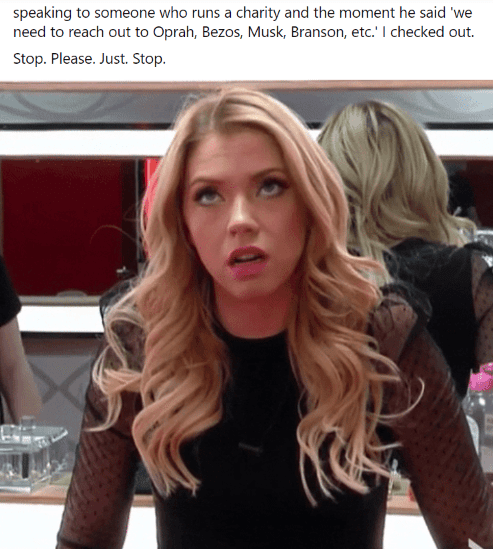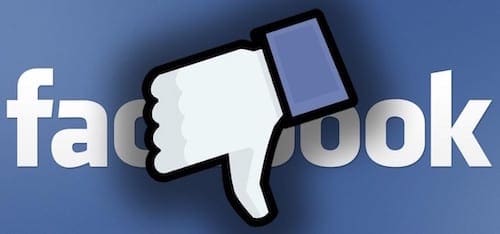The following phone conversation took place in 2009.
Nonprofit CEO: We’d like your help in running a million-dollar campaign using Facebook.
Me: Great! How big of a following do you have on Facebook?
CEO: Not big. A couple hundred.
Me: How big is your email list?
CEO: Also a couple hundred.
Me: Given those numbers, how exactly do you plan to raise one million dollars from such a small audience?
CEO: Well last year Barack Obama raised millions in small donations online and via Facebook. So we can do the same!
Stop Calling Oprah!
Lest you think that almost never happens, here’s a Facebook post from a friend of mine from August 11:

Every time I post about this issue on Twitter, I get tons of replies from nonprofit consultants who have had similar conversations with CEO’s and fundraisers. I guess people must think we all have a rolodex with personal information of the 500 richest, most famous people in the world and we’re just waiting for YOU to call us so we can tap into that network and get your nonprofit a 7… heck, 8 figure donation!
ALL. THE. EYEROLLS.
I know that lately MacKenzie Scott has been donating billions to charity and this of course has fueled a “why not us?” reaction in the sector. Just look at the data: The amount of people donating in the United States has gone down but the total amount of money donated has gone up.
Bigger donations are in, smaller donations are out! Let’s forget small donors and spend time, effort and money hunting down the big fish.
Have you ever heard the term ‘needle in a haystack’? What makes you think you can
a) connect with the rich and famous and
b) you’ll convince them to donate to your organization, when they have 5,000 other causes trying the exact same thing?!
This kind of sector thinking drives me up a wall.
To use a baseball analogy: Stop swinging for the fences and trying for only homeruns. Go for singles. The more singles, the more runs score.
With fundraising: Stop looking for major gifts in all the wrong places.
Small Donors, Big Returns
Take a step back for a sec. You need to raise X each year. Why? So you can service more people and have more impact in the community.
What will help make that happen: Trying desperately to contact Oprah or connecting with more local donors so they can solve a problem in their community with your help?
Follow up question: Are you ignoring small donors because their $10 donation “doesn’t move the needle”? Have you started putting an emphasis on major gifts while abandoning small donations?
Then you’re doing it wrong.
Let’s look at those small donors who are “a waste of your time.” They give $10 this year. Build the relationship with them and that amount will grow year over year. In fact, your next major gift could be from someone who started out as a very small donor.
I know, I know. That forces you to think long-term as opposed to RIGHT NOW. But if you’re the CEO or fundraiser, THAT’S YOUR JOB! You should be worried about the health of your organization, today, tomorrow and 5 years into the future. If you’re not, then you’re not only hurting your charity. You’re hurting the people in your community who desperately rely on your services and programming.
What happens when you ignore small donors? Well, they’ll always remain a one-time $10 donor and you’ll never know what could’ve been.

Courtesy: https://imgflip.com/i/5kf743
Recurring Donor Program
Does your nonprofit have a monthly giving/recurring donor program? If not, time to get one set up. Today.
The person who donates $10 every month has a higher lifetime value and higher retention rate than other donors. Yup, $10 a month starts to add up over time. And if you’re monthly giving program is set up correctly, you’ll be able to increase that monthly amount as the years go by.
Consider this: 100 monthly donors giving $10 means $12,000 a year. That’s a steady monthly revenue stream and helps you plan your budget and programming.
You have the potential for way more than 100 givers per month? Go for it! Offer the option on your online donation page. Present it via emails to newsletter subscribers. Offer it to volunteers who may also want to become donors. Recommend it to people who right now can’t give a one-time gift of $100 but CAN make a stretch gift of $120 over the course of twelve months.
It’s low-hanging fruit with high value. Why abandon that to chase the unreachable?
Build Relationships And They Will Come
45% overall sector donor retention rate. Abysmal.
18-20% retention rate for first-time donors. Pathetic.
As a sector we can’t seem to keep our current donors. We gain new donors and then we lose the vast majority of them. But hey, why bother with them when all you need to do is get Warren Buffet’s number and you’re guaranteed a huge check?!
Sigh.
Let me leave you with a little secret: Your potential mid and major gifts donors? They already exist in your database. They’re people you have a good relationship with. They’ve donated small amounts for the last few years. They are loyal to your organization. They may be ready to discuss increasing their donation.
Those are the people you should be targeting. I guarantee they’re much easier to get in touch with than Beyonce.
As a former CEO and fundraiser, I always recommend to clients to build a donor pyramid whose base is full of small donors. In good and bad financial times, they won’t leave you. They are the foundation of your giving pyramid and won’t let your organization crumble.
Stop chasing fantasies. Pursue realities.
P.S. I hope you don’t get the impression I am advocating to put all your eggs in the small donor basket. Far from it! Your organization should be soliciting small, midsize and large gifts. Submitting grant proposals. Operating a gifts in wills program. Events. Cause marketing. And on and on.
If you went to an investor, they’d tell you to diversify your investment portfolio, rather than putting everything into Dogecoin. Same applies to fundraising: Diversify your fundraising portfolio. Provide potential and current donors with a few options for their giving.
Don’t put all your eggs in the Oprah basket. She may never return your call. (And if she does, who says she’ll give you more than $10?!)




Right on Ephraim. And to build on what you’re saying, those $10 a month donors are the ones that can leave you a gift in their will which, on average, is approximately between $55-65,000. But, you know, it requires a long-term view (which is sometimes hard to come by) and it requires effort.
Which raises another question: why are CEOs or fundraisers willing to make a (futile) effort to connect with the ultra rich in the faint hope of getting a massive gift, but aren’t willing to make an effort to develop stronger relationships with those donors who are already donating to the charity?
Misplaced or, better yet, questionably placed effort is the key question here.
Because they “know someone” who once got a 7 figure check. So they figure they can too? No clue. But like you said, plenty of diamonds can be found in donors donating in small amounts.
“Which raises another question: why are CEOs or fundraisers willing to make a (futile) effort to connect with the ultra rich in the faint hope of getting a massive gift, but aren’t willing to make an effort to develop stronger relationships with those donors who are already donating to the charity?”
Ligia, you answered your own question: effort. Or perceived effort. “One gift from RICH PERSON would cover all our needs!”
It’s silly, lazy, fantasy stuff.
Do. The. Work. People.
(And I once seriously got the Oprah question. And before that the Spielberg question.)
Darn- I forgot about Spielberg! So many rich people to ask, so little time…
Ephraim,
Perfectly written column, although probably preaching to the choir. In addition to “let’s find rich people and ask them for money”, I also am told by the Board to “write more grants” (because they don’t understand that you write proposals with the hope of receiving grants. But I digress). Sigh.
Thank you.
Catherine-
Thank you!
I feel your pain.